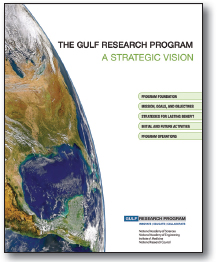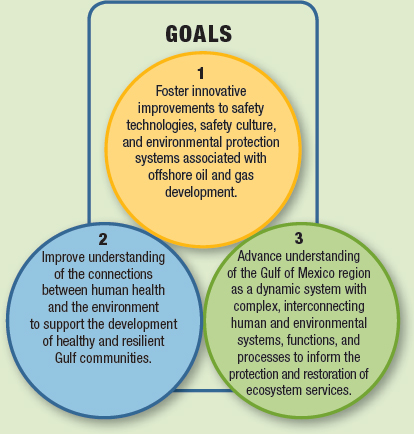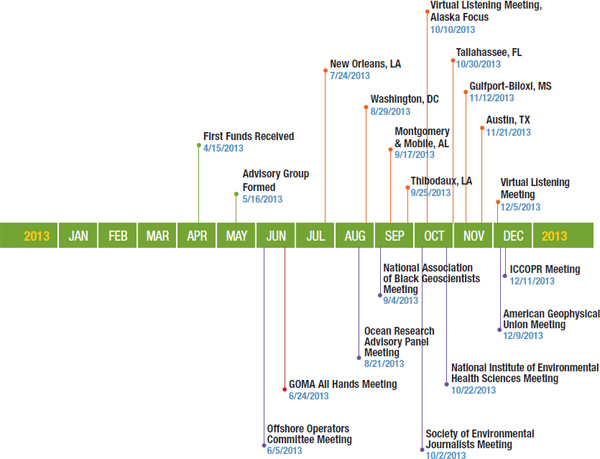The extensive information-gathering of the first year helped inform the Advisory Group’s thinking, both clarifying what the Program could do within the broad boundaries established by the agreement language and identifying areas to avoid, so the Program would not duplicate other efforts. One strong message was that the new

Program, in contrast to much existing research, should be forward-looking. Rather than focus solely on the impacts of the DWH disaster, the Program will seek to prevent and minimize harms from similar events in the future and ensure that what’s been learned is applied to benefit the Gulf region and the Nation.
The Program’s strategic vision was released in September 2014. Recognizing that the Program would evolve over time, the Advisory Group developed elements of the strategic vision that could provide guidance over the long term (see Mission):
- The mission reflects the broad scope of the Program and areas of focus, which help distinguish it from other DWH-related research programs.
- Three goals support this mission and describe high-level aspirations, highlighting the desire to work at the intersection between two or more of the Program’s three areas of responsibility: oil system safety, human health, and environmental resources.
- Six strategies for lasting benefit characterize how the Program will achieve its goals over the long term. These strategies seek to ensure that the Program continuously builds on its defining features and strengths, even as the Program evolves and new needs, opportunities, and challenges arise.
As planning proceeded, the Advisory Group determined that the Program also needed to begin operating, and in mid-2014 the Program began to design and implement a small suite of initial funding opportunities to be awarded in 2015 and 2016. These initial opportunities were announced in late 2014, with the application and review processes scheduled for 2015. The goal was to turn some of our early discussions, especially at the opportunity workshops, into concrete funding opportunities. This would show the community that the Program was committed to disbursing funds as soon as possible and signal important aspects of the Program’s design, such as fostering cross-boundary approaches and supporting leadership development. The 2015 funding opportunities are described on pages 10-11.
MISSION
Over its 30-year duration, the Gulf Research Program will work to enhance oil system safety and the protection of human health and the environment in the Gulf of Mexico and other U.S. outer continental shelf areas by seeking to improve understanding of the region’s interconnecting human, environmental, and energy systems and fostering application of these insights to benefit Gulf communities, ecosystems, and the Nation.

STRATEGIES FOR LASTING BENEFIT
Long-term, cross-boundary perspective that supports activities that take advantage of the Program’s 30-year duration and activities that cross geographic, disciplinary, and sectoral boundaries
Science to advance understanding by bringing the best scientific, health, and engineering expertise to address large, complex issues.
Science to meet community needs. In other words, what are the information needs of the public, resource managers, or community planners? And how can scientific information be better applied to policy decisions?
Encourage synthesis and integration of the significant amount of data and information already available in order to produce novel insights and to encourage translation of new understanding into action.
Operate in ways that leverage Program funds – through coordination and partnerships with other organizations and funders.
Invest in leadership and capacity building to develop people with the skills and abilities needed to solve complex problems and to spark and support innovation.
GULF RESEARCH PROGRAM 2015 FUNDING ACTIVITIES
| 2015 Award | Announce Date | Open Date | Close Date | Award Date/ Anticipated Release |
| Exploratory Grants – Award Year 2015 | December 1, 2014 | December 18, 2014 | March 30, 2015 | September 2015 |
| Early-Career Research Fellowships | December 1, 2014 | December 18, 2014 | February 06, 2015 | June 2015 |
| Science Policy Fellowships | December 1, 2014 | December 18, 2014 | February 06, 2015 | June 2015 |
| Data Synthesis Grants – Award Year 2015 | April 16, 2015 | May 4, 2015 | July 31, 2015 | December 2015 |
| Academies Study on Effective Approaches for Monitoring and Assessing Gulf of Mexico Restoration Activities | March 19, 2015 | NA | NA | September 2016 |
2015 Exploratory Grants: One-year grants intended to catalyze innovative thinking about how to effectively educate and train offshore oil and gas and health professionals, or how to improve understanding of links between human well-being and ecosystem services related to oil and gas production. Awards will be announced in early fall 2015.
2015 Fellowships: As an initial contribution in education and capacity-building, the Program initiated two new fellowship programs and committed to participate in a third existing program of the Academies. The fellowships support individuals from a broad range of disciplines from the social sciences to engineering. The two new fellowships are Gulf-based and designed to encourage cross-boundary approaches to critical issues in the Gulf region that span oil system safety, human health, and environmental resources. See the Gulf Research Program website for the 2015 awardees.
- The early-career research fellowship: These 2-year research fellowships recognize pre-tenure professionals for exceptional leadership, research excellence, and potential for future contributions to improving oil system safety, human health, or the environment.
- The science policy fellowship: These 1-year fellowships place awardees at a state environmental, natural resources, oil and gas, or public health agency, or the regional office of a relevant federal agency in the Gulf of Mexico to gain science policy experience.
- The Christine Mirzayan Science and Technology Policy Graduate Fellowship: Through this existing 12-week program based at the Academies in Washington, DC, the Gulf Research Program will provide a Gulf-oriented fellow with an opportunity to experience the role of science in Washington and to work directly with Pro ram staff In earl 2014 the Pro ram hosted its first fellow, Jocelyn Oshrin, who grew up in Mississippi and earned an MS/MPA degree in Environmental Science (see sidebar).
2015 Data Synthesis Grants: These 2-year awards are designed to encourage activities that synthesize existing data in ways that inform efforts to restore and maintain the Gulf of Mexico’s ecosystem services or that enhance understanding of the deep Gulf or its physical and biological connectivity to coastal communities. This opportunity addresses a theme heard often in outreach meetings—that existing monitoring programs generate a great deal of data, yet there is comparatively little synthesis and use of these data. Awards will be announced in early 2016.
The first consensus study funded by the Gulf Research Program and to be carried out by the Academies is designed to provide practical guidance on effective approaches for monitoring and assessing Gulf restoration. The study concept was developed with help from other DWH-related funders and agencies, including the National Fish and Wildlife Foundation, the RESTORE Council, NOAA, and a number of other federal and state agencies with restoration responsibilities. The study committee began its work in early 2015 and will deliver its results in 2016. (See Restoration Monitoring Consensus Study.)
2014 Christine Mirzayan Science and Technology Policy Fellow
Jocelyn Oshrin (MS, MPA, Environmental Science, Indiana University School of Public and Environmental Affairs) is originally from Mississippi and was selected to be the first Gulf Research Program Christine Mirzayan Science and Technology Policy Fellow in the winter of 2014.

Working with Program staff in Washington, DC, Jocelyn used her knowledge of the Gulf environment and communities to contribute to the Program’s first year through numerous activities, including assisting with the planning of a workshop on education and training opportunities, performing background research on environmental monitoring and public health issues in the Gulf region, and contributing to the drafting of the strategic vision. After completing the fellowship, Jocelyn moved to Richmond, Virginia, to work as an environmental scientist with ECS Mid-Atlantic on a variety of projects including environmental site assessments, groundwater and soil investigation, and wetland services. Here she answers a few questions about her fellowship experience:
What was the most valuable part of your fellowship experience? The most valuable part of my fellowship experience was the guidance I got from Academies staff, my amazing mentor, the Gulf Research Program’s Advisory Group members, my Mirzayan fellowship cohorts, and others in science-policy fields. I value the research, writing, organizational, and critical thinking skills I gained through contributing to the Program’s strategic plan, and the career advice and support I received during the fellowship has been invaluable.
Did you learn anything (about the Gulf Research Program, the Academies, DC, yourself) that surprised you? I was surprised to learn the extent of career possibilities for scientists in policy fields. The majority of people I met at the Academies, as well as other organizations in DC, came from research backgrounds and had developed successful careers in policy.
What advice would you give to future fellows? My advice to future fellows would be to take advantage of all of the introductions the fellowship provides. Talk to everyone because everyone has valuable advice (or at least something interesting to say). Conducting informational interviews with organizations that interest you is invaluable, and having a connection to the Academies really helps get meetings with people in high places. Also, take advantage of activities outside of the Keck Center—go to a congressional hearing, tour the capital, visit the museums. The attractions in DC are limitless!
Gulf Research Program organized meetings and milestones
ORANGE: Meetings
GREEN: Strategic plan milestone
GREY: Funding/Fellowship Opportunity milestones

Meetings the Gulf Research Program participated in as speakers/presenters
RED: Gulf region meetings
PURPLE: National meetings







